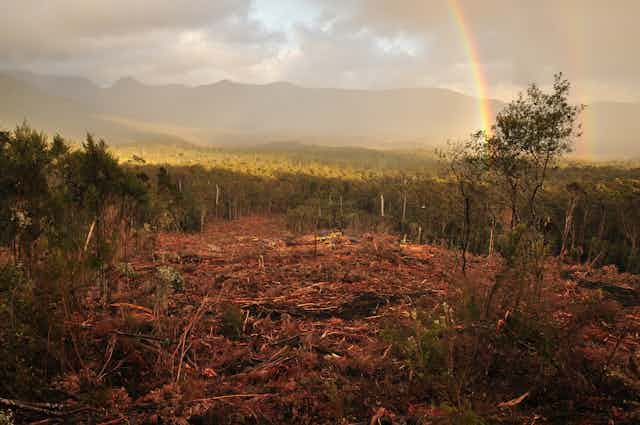Australian forestry is shifting: in recent months some states have moved to log less, some more. More logging brings protests about environmental values; less, complaints about how it will affect the state’s economy. But there is a way to extract timber sustainably, and keep everyone happy.
Different sides to the forestry story
Tasmania is transitioning native forests to non-timber-producing reserves. Meanwhile in Queensland native forests that were to be removed from timber production may now be reopened to forestry.
The harvest in Tasmania and Queensland is largely driven by a small portion of wood going to high-quality, high-value products like flooring and furniture, which can’t be made from plantation timber.
The problem is that sustainable forest management, by its very nature, is a field that can be highly divisive. In 2004, Heiner Schanz from the University of Freiberg reviewed the literature on sustainable forest management and found more than 14 different definitions. He noted that controversy should almost be expected. Any one definition of sustainable forestry valued one of the five dimensions of forest management (ecological, economic, social, temporal and spatial) at the expense of others.

In my experience, responsible forest managers and environmental groups often want the same thing. Both seek to have a healthy, productive, vibrant and diverse forest for future generations. The difference tends to emerge with economic expectations. Forest managers see the extraction of timber as a cornerstone of sustainable forest management. Environmentalists see it as the main destructive force for all the potential forest values.
Learning from the past
In industrialised nations like Canada and Australia, concerns about the forest damage and devastation caused by timber harvesting and extraction are largely linked to practices from decades ago. You will be hard-pressed to find a forest manager who won’t openly acknowledge these past mistakes. But management of these operations was based on the knowledge, technology and social interest of the time, all of which have since improved. We have better forestry today.
I have even seen a number of examples in recent years where forest harvesting activities have been used to correct past mistakes. For example, management plans and harvest operations in Germany try to return forest biodiversity to the state it was in decades or even centuries ago. Over the past century, forest management favoured certain species in the mixed forests in Germany’s Bavaria. Over the last few decades, forest management has promoted the growth of those under-represented species. The economic value is still important but clearly being managed in balance with other forest values.
Some environmental groups in Victoria have acknowledged the potential for sustainable forest management. The Wombat State Forest was over-exploited in the past, and was placed in reserve as a community forest in the early 2000s. It has become a focal point for regeneration of native forests. Community groups advocating for the protection and regeneration of that forest do not want to see it go back to traditional timber production use. But when plans to eliminate timber cutting entirely were raised, many of those groups indicated that active forestry interventions were critical to rebuilding the ecological, environmental and social values of that forest.
Even with the problems caused by past forest management, many of the forested areas identified in Tasmania for protection as “high conservation value forests” have been harvested in the past. Some would argue they are in such good shape as a result of good sustainable forest management.

Can we get it right?
I believe native forests can be sustainably managed with timber extraction. This balance can give a region a thriving forest industry while sustaining and enhancing the many other values we have for forests in our society.
Examples around the world show that forests can be managed to deliver the economic values of timber for construction, fibre for pulp and paper, and increasingly as a feedstock for renewable chemicals and energy. Finland and Sweden not only have sustained and grown their traditional timber industries but are emerging as world leaders in renewable energy from biomass. And they are still considered to have some of the most pristine landscapes in the world.
I have a small family property in Canada that has been owned by our family since the original settlement of the area. Over the years it has provided timber to the mill, but still been a favourite spot of the community for hunting, fishing and other recreation activities. It is well on track to provide the same for future generations.
As the contrasting policies in Queensland and Tasmania play out it will present many research opportunities related to the five dimensions of sustainable forest management. I for one will watch with great interest how the regional development in the forested regions of Queensland stack up to those in Tasmania.

